Have you ever wondered how some spaces instantly feel inviting, balanced, and inspiring? Interior design mood boards have become a beloved tool for transforming visions into reality, helping you visualize color schemes, textures, and styles all in one inspiring collage. Their popularity lies in their ability to spark creativity, clarify ideas, and serve as a roadmap for creating harmonious spaces—whether you’re decorating a cozy nook or a sprawling living room.
In this article, you’ll find a treasure trove of ideas and practical tips to craft your perfect mood board. From calming neutrals to vibrant bohemian mixes, we’ll explore a diverse range of styles and themes that can elevate any interior. Get ready to gather inspiration, experiment with different elements, and discover the perfect combination to turn your space into a beautifully cohesive sanctuary!
1. Neutral Color Palettes for Calm and Balance

A neutral color palette creates a timeless and peaceful foundation that instantly soothes the mind and promotes a sense of balance in any space. These shades serve as a versatile backdrop, allowing other design elements to shine without overwhelming the senses.
Imagine a room bathed in soft beiges, warm taupes, and calming greys. The walls are painted in a gentle, matte finish, providing a subtle warmth that invites relaxation. A plush, cream-colored sofa is accented by light wood furniture and textured throws in oatmeal and stone tones. The overall atmosphere feels airy and uncluttered, with natural light enhancing the understated elegance. The tactile sensation of soft textiles combined with the gentle, muted hues fosters a sense of calm that encourages unwinding after a long day.
To recreate this look, start with a neutral base for your walls—think beige or light grey paint or wallpaper. Incorporate furniture in natural woods or upholstered pieces in soft fabrics like linen or cotton. Add accessories such as plush cushions, throws, and rugs in shades of ivory, taupe, or warm grey to deepen the sense of harmony. Keep decor minimal, focusing on clean lines and simple forms. This approach is perfect for beginners, and sourcing affordable options like cotton throws and laminate wood furniture makes it accessible for any budget.
2. Minimalist Style with Clean Lines and Clutter-Free Layouts

Minimalism emphasizes simplicity and order, creating spaces that feel peaceful and uncluttered—perfect for achieving visual harmony and reducing stress. This style relies on a restrained color palette, streamlined furniture, and thoughtful organization to promote a sense of calm.
Picture a room with sleek, low-profile furniture featuring straight, unadorned lines—think a Scandinavian-inspired white coffee table, a streamlined sofa, and unobtrusive storage units. The space is free of excess decor, with only a few select objects, such as a simple ceramic vase or a geometric sculpture, placed deliberately. The floors are clear, perhaps covered with a soft neutral rug, and surfaces are kept tidy. Natural light floods the space, bouncing off smooth surfaces and highlighting the clean, crisp aesthetic. The overall atmosphere is one of orderliness that invites relaxation and focus.
To achieve this look, choose furniture with simple, geometric forms—opt for pieces in neutral colors like white, beige, or black. Keep surfaces clear by using hidden storage solutions and avoid unnecessary decorative clutter. Use a few high-quality essentials like a sleek lamp or a minimalist clock to add function without distraction. Use baskets or storage boxes to organize smaller items. This style is beginner-friendly, and sourcing affordable, minimalist furniture from stores like IKEA or secondhand shops makes it easy to implement without a big budget.
3. Warm Earth Tones for Cozy and Inviting Vibes
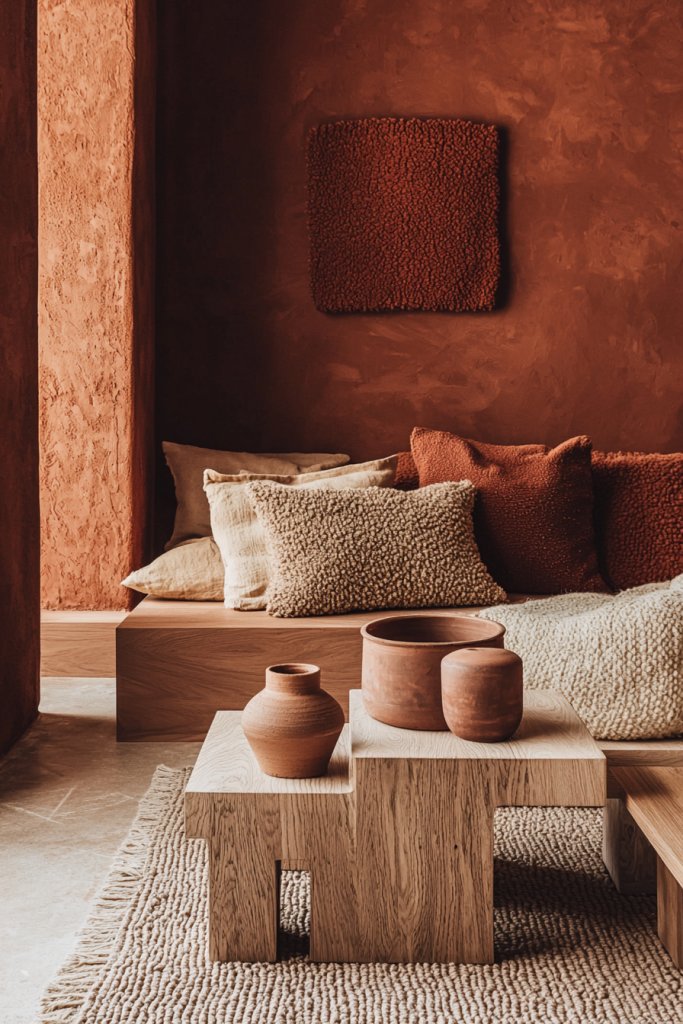
Warm earth tones evoke feelings of comfort, security, and connection to nature, making them ideal for creating cozy and welcoming interiors. These colors—such as terracotta, rust, and rich browns—bring depth and richness to a space, encouraging relaxation and socializing.
Visualize a living room with terracotta-colored walls or accents, complemented by a deep rust-colored throw blanket draped over a textured, caramel-hued sofa. The flooring might feature warm wooden planks or a plush, chocolate-brown rug. Decor items like ceramic vases, woven baskets, and vintage-inspired lamps in warm tones add layers of visual interest. The scent of natural wood and subtle spices might fill the air, while soft lighting enhances the inviting atmosphere. The overall space feels grounded and personal, perfect for gatherings or quiet evenings at home.
To recreate this cozy look, select warm-toned paint or wallpaper as your base. Incorporate decor in shades of burnt orange, terracotta, or warm browns—think ceramic pottery, leather cushions, or rattan baskets. Use textured textiles like chunky knit throws or velvet cushions to add tactile warmth. Wooden furniture in warm finishes—oak, teak, or walnut—completes the earthy aesthetic. Affordable options can be found at vintage stores or via online marketplaces, making this style accessible for many budgets.
4. Monochromatic Theme for Cohesive and Elegant Looks
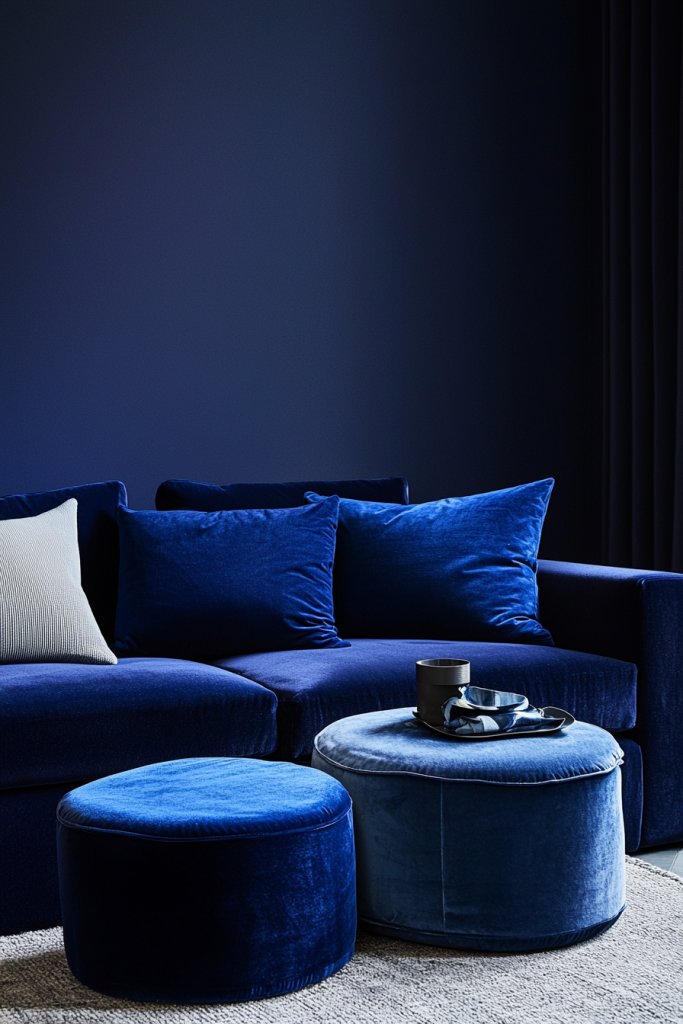
A monochromatic color scheme uses variations of a single hue to create a unified and sophisticated space that feels both harmonious and refined. This approach enhances visual flow and can make even small rooms appear larger and more cohesive.
Imagine a bedroom decorated entirely in shades of soft blush pink: walls painted in a muted pastel, complemented by blush-toned bedding, curtains, and decorative pillows. Incorporate slightly darker or lighter shades of the same color in rugs, lamps, and artwork to add depth. The textures are varied—think silky sheets, matte ceramics, and plush rugs—creating tactile interest without disrupting the color harmony. The space feels elegant yet calming, with a seamless flow that draws the eye smoothly around the room.
To implement this style, pick a core color—such as grey, beige, or blush—and select different shades and textures within that palette. Use paint, textiles, and decor items that vary in tone but stay within the chosen hue family. Incorporate different materials like velvet, linen, and matte ceramics to add depth. Keep accessories minimal to maintain the clean, cohesive look. This approach is beginner-friendly, especially when sourcing affordable monochrome textiles and decor from stores like IKEA or online shops, allowing for easy customization.
5. Textured Fabrics and Soft Textiles for Depth and Comfort
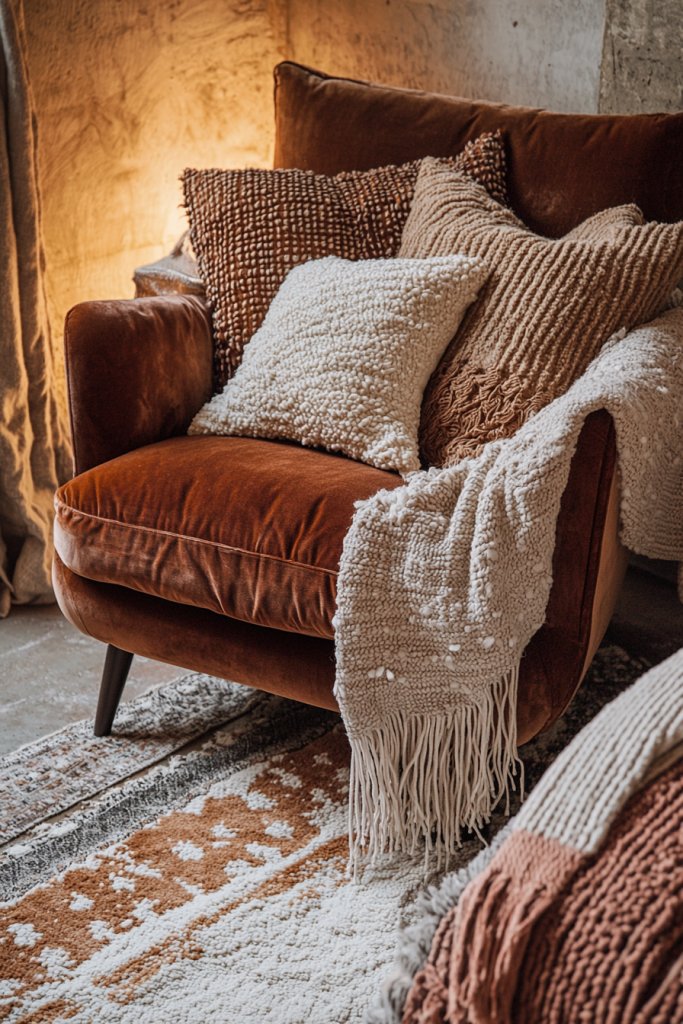
Adding textured fabrics and soft textiles brings warmth, depth, and a tactile dimension to any interior. These elements make a space feel more inviting and cozy, encouraging relaxation and sensory pleasure.
Envision a living room with a plush, shaggy area rug in oatmeal, layered with a chunky knit throw in cream, and accented by velvet cushions in muted earth tones. The sofa might be dressed in a soft linen slipcover, while curtains are in textured linen or waffle-weave fabric. These textiles invite touch and add visual interest through their varied textures. The overall environment feels soft, layered, and calming, with a gentle soundscape created by rustling fabrics and cozy textures that enhance the sense of comfort.
To achieve this, select textiles with rich textures—think woven, boucle, velvet, or chunky knits. Incorporate these textiles into rugs, cushions, throws, and curtains, choosing colors that complement your overall palette. For a DIY approach, you can sew or repurpose existing fabrics—adding a chunky knit throw or replacing standard cushions with textured covers. Affordable options are widely available at home goods stores or secondhand shops, making it easy to introduce tactile interest without a hefty investment. These textiles transform a simple space into a cozy retreat effortlessly.
6. Natural Materials: Wood, Stone, and Rattan
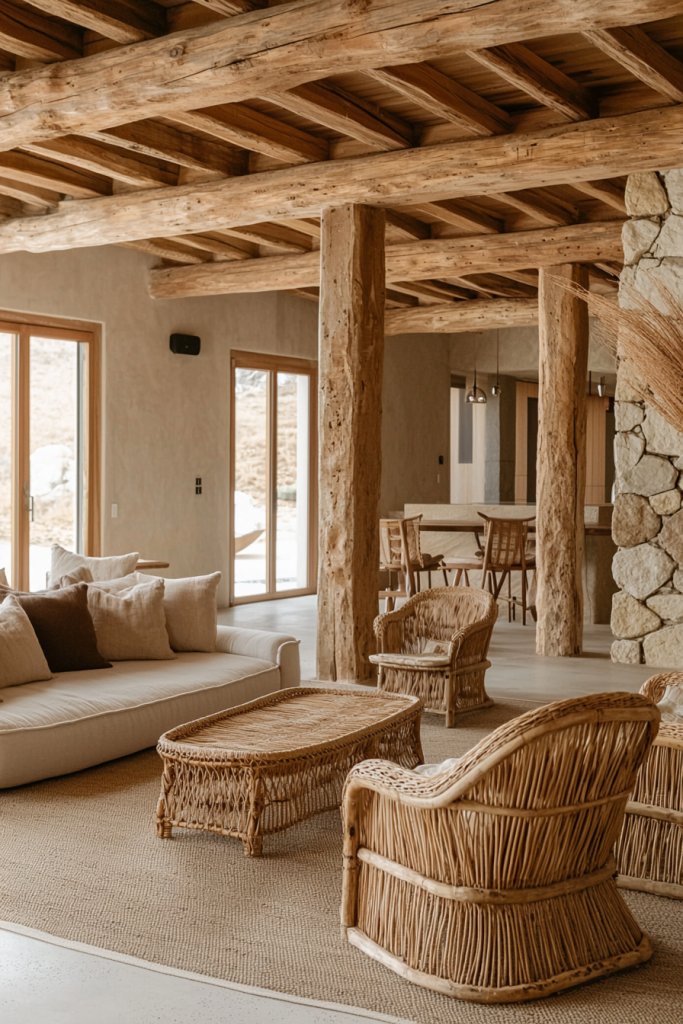
Bringing natural materials into your interior design mood board instantly creates an earthy, grounded vibe that feels both calming and authentic. These textures evoke a sense of connection to the outdoors, making any space feel more inviting and warm.
Imagine a room where light-colored wood furniture like a Scandinavian-style coffee table or rough-hewn stone accessories adorn the shelves. Rattan baskets or chairs add a tactile, woven element that invites touch. The color palette leans toward warm beiges, soft browns, and natural greys, complemented by the organic textures of these materials. The space might emit a subtle woody scent or the faint aroma of natural fibers, enhancing the sensory experience. Overall, this style balances ruggedness with refinement, creating a cozy yet sophisticated atmosphere.
To recreate this look, start with a wooden coffee table or sideboards—opt for reclaimed or sustainably sourced options for eco-consciousness. Incorporate stone decor pieces like vases or coasters, and add rattan baskets or chairs to introduce texture and storage solutions. Mix and match these elements with neutral-toned textiles, such as linen curtains or wool throws. These materials are widely available at home improvement stores, antique shops, or online marketplaces, making it easy to assemble an authentic natural-inspired mood board without breaking the bank.
7. Scandinavian-inspired Simplicity with Light Wood and White Accents

Achieving that signature Scandinavian aesthetic means embracing minimalism and functionality, with a focus on bright, airy spaces that promote calm. This style emphasizes light wood tones combined with crisp white accents, creating a space that feels fresh and uncluttered.
Picture a room bathed in natural light, with white walls and ceilings serving as a clean backdrop. Light wood furniture such as a sleek dining table or minimalist shelving units anchors the space, while subtle decorative touches like white ceramic vases or simple framed prints add to the aesthetic. Textures are kept soft and understated—think linen cushions, cotton curtains, or wool rugs—which add warmth without visual clutter. The overall vibe is bright, spacious, and inviting, with a soothing, almost zen-like quality that encourages relaxation.
To implement this look, start with white paint or wallpaper as your base. Incorporate light wood furniture—think birch, ash, or pine—preferably with clean, simple lines. Use white or neutral textiles for curtains, cushions, and throws to maintain the airy feel. Keep decor minimal; opt for functional storage solutions like open shelving to display a few curated objects. These elements are accessible at most furniture stores or DIY shops, making it straightforward to craft a cohesive, Scandinavian-inspired space that feels effortlessly stylish.
8. Coastal Vibes with Soft Blues and Seashell Decor

Transform your space into a breezy, seaside retreat by channeling coastal vibes through soft blue hues and maritime-inspired decor. This theme instantly evokes relaxation, reminiscent of sandy beaches and ocean waves.
Visualize a room painted in light, airy blues—like pale aqua or sky blue—paired with white trim and furniture. Soft textiles such as linen curtains, cotton cushions, or woven throws in shades of sand and sea add comfort and texture. Decor elements like seashells, driftwood sculptures, or nautical lanterns serve as focal points, bringing a subtle maritime charm. The space feels fresh and invigorating, with a hint of salt air and the gentle sound of waves, creating a calming sanctuary perfect for unwinding.
Begin by choosing a cool blue color palette for walls or accent pieces. Add nautical decor like seashells in glass jars or driftwood accents on shelves. Incorporate light-colored wood furniture and natural fibers—such as jute or seagrass rugs—to enhance the coastal feel. Finish with white or beige textiles to keep the space light and breezy. These decor elements are readily available online or in home goods stores, making it easy to capture that seaside tranquility in your own home.
9. Rustic Charm with Vintage Furniture and Warm Decor
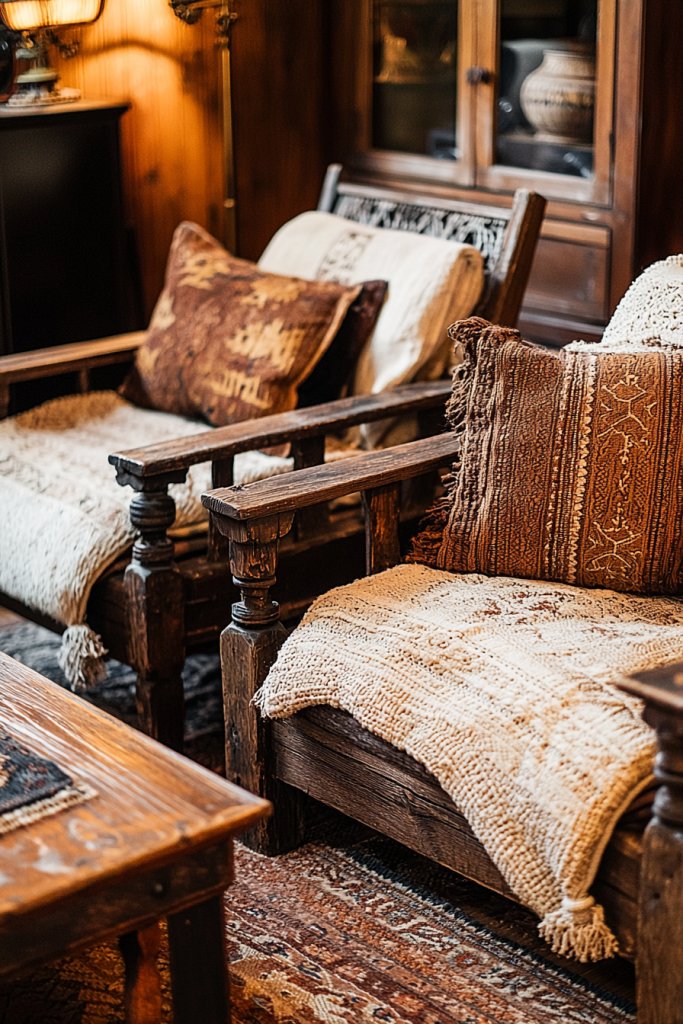
Infuse your space with cozy, rustic charm through vintage furniture pieces and warm, inviting decor. This style celebrates history and craftsmanship, creating a lived-in, welcoming environment.
Picture a room featuring distressed wooden furniture, like a vintage sideboard or farmhouse dining table, paired with warm-toned textiles such as plush throws and velvet cushions. Antique finds—like a weathered mirror or a brass lamp—add character, while warm lighting from Edison bulbs or soft lamps enhances the cozy ambiance. The overall aesthetic combines rustic elements with a hint of glamour, making the space feel both nostalgic and elegant.
To achieve this look, start with vintage or distressed wood furniture sourced from thrift stores or antique markets. Layer in textiles like a velvet cushion in deep emerald or a knit throw blanket in warm rust tones. Incorporate warm metal accents—such as brass or antique gold—and add dim, warm lighting for an inviting glow. For a finishing touch, include vintage ceramics or decorative objects that tell a story. These elements are accessible and affordable, allowing you to craft a charming rustic space filled with personality.
10. Modern Elegance with Metallic Accents and Sleek Surfaces
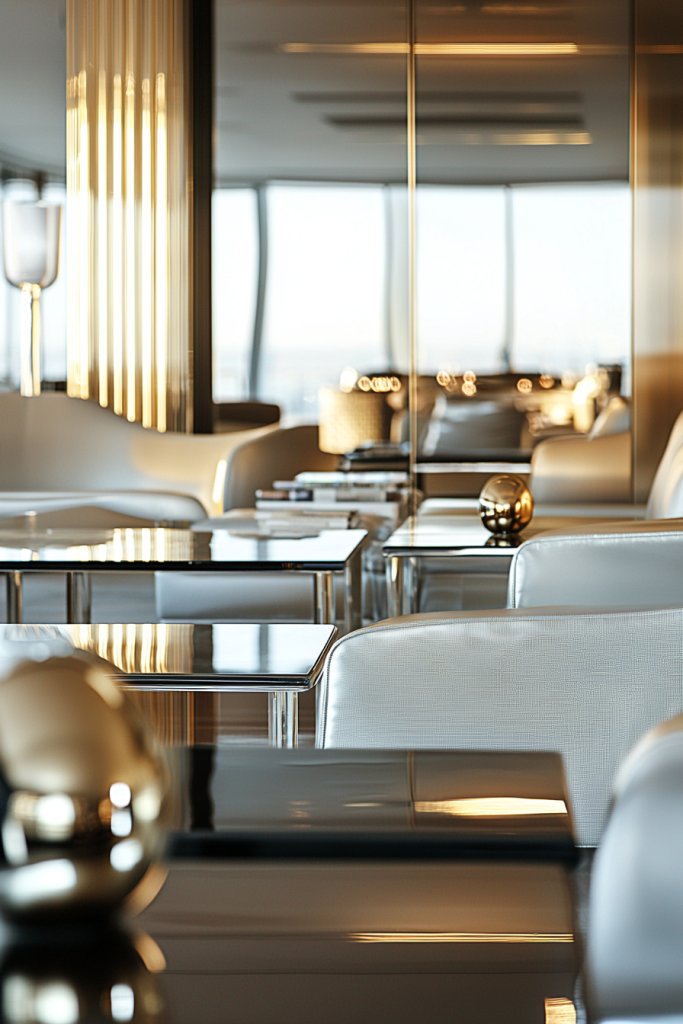
Create a refined, contemporary look with metallic accents and sleek surfaces that exude sophistication. This style combines modern minimalism with luxe details for an effortlessly chic atmosphere.
Envision a space with high-gloss surfaces, like a glass coffee table or marble countertops, accented by gold or brass fixtures—such as pendant lights or handles. The color palette revolves around monochromatic tones, mainly black, white, and metallics, with smooth, reflective textures that catch the light. Sleek furniture with clean lines and minimal ornamentation creates a sense of order and clarity. The overall mood is polished, elegant, and modern, perfect for those who appreciate luxe but understated design.
To recreate this look, opt for furniture with smooth, glossy finishes—like a black lacquer sideboard or glass-topped table. Incorporate metallic accents through lamps, picture frames, or decorative objects in gold, silver, or brass. Use white walls to maximize brightness and contrast these elements sharply. Keep accessories minimal, focusing on quality over quantity, and choose statement lighting fixtures to serve as focal points. These stylish components are widely available from modern furniture and lighting stores, making it easy to achieve a high-end, modern aesthetic at home.
11. Bohemian Mix of Patterns, Textures, and Vibrant Hues
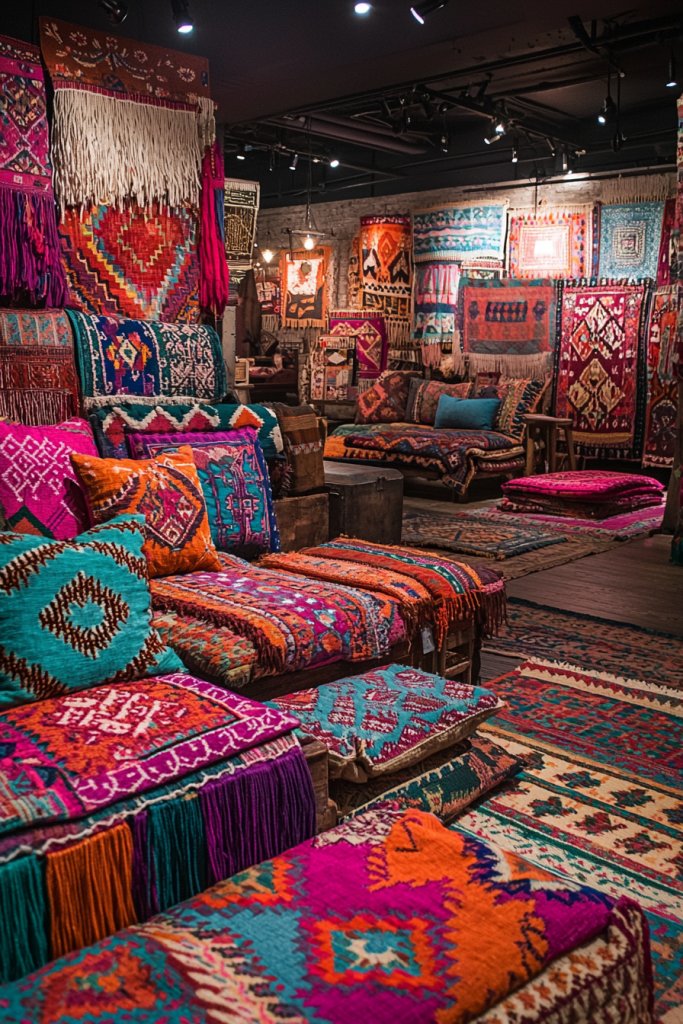
Embracing a bohemian aesthetic means creating a space full of personality, color, and layered textures that evoke a carefree, artistic vibe. This style thrives on mixing patterns, from intricate Moroccan rugs to bold, colorful cushions, resulting in an eclectic, vibrant atmosphere. It’s about celebrating individuality and spontaneity, making your space feel like a curated collection of your favorite things.
Imagine a cozy corner where a patchwork kilim rug with rich reds, oranges, and deep blues anchors the room. Plush cushions with embroidered, floral, and geometric patterns are scattered on a vintage velvet armchair. Layered textiles—like fringed throws, tassel-detailed curtains, and woven wall hangings—add tactile richness. Scattered artisanal ceramics and quirky sculptures complete the scene, blending warm earthy tones with pops of vibrant color. The space feels inviting, lively, and full of stories, with a sensory mix of textures and hues that inspire creativity and relaxation.
To recreate this look, start with a statement rug featuring bold patterns and warm colors. Mix and match cushions with different prints and textures, such as embroidered pillow covers or fringed throws. Incorporate a variety of decorative ceramics and woven baskets to add depth. Use a mix of vintage and handmade accessories to emphasize the eclectic vibe. Layer textiles and arrange decorative objects in a seemingly casual but thoughtfully curated way, ensuring the space feels both lively and harmonious without feeling cluttered.
12. Scandinavian Minimalism with Functional Decor
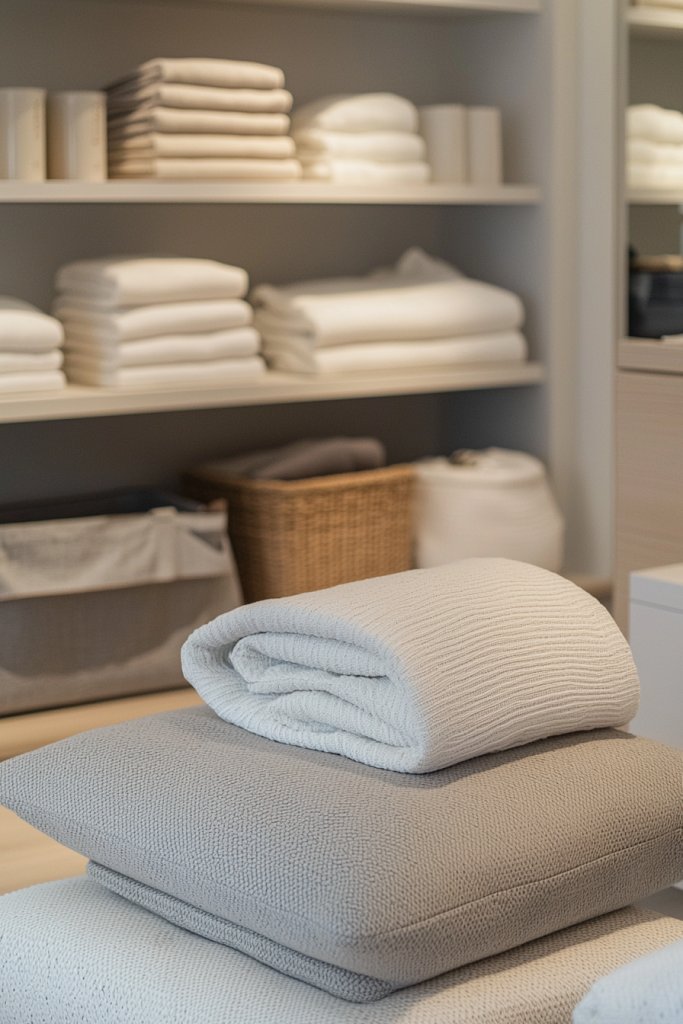
Scandinavian minimalism champions simplicity, functionality, and a sense of calm, making it perfect for creating a peaceful and clutter-free environment. This style emphasizes clean lines, neutral color palettes, and practical decor elements that serve both aesthetic and everyday needs. It’s designed to foster mental clarity and comfort, ideal for those seeking understated elegance.
Picture a bright, airy room with walls painted in soft whites or light greys, complemented by pale pine or oak furniture. The space features sleek, simple furniture with smooth contours—think a streamlined sofa, a minimalist coffee table, and Scandinavian-style chairs. Textiles are subtle yet cozy, like a soft cream throw blanket with chunky knit texture, and a plush sheepskin rug adds warmth underfoot. The overall atmosphere is quiet and harmonious, with natural light flooding in through large windows, highlighting the understated beauty of each element. The mood board exudes calm, practicality, and timeless sophistication.
To achieve this look, select furniture with clean, geometric shapes made from light woods like birch or pine. Choose neutral textiles such as linen curtains, wool throws, and woven baskets for storage. Keep decor minimal—perhaps just a few understated vases or ceramic bowls—and focus on maximizing natural light. Incorporate functional pieces like multi-use storage ottomans or sleek shelving to maintain order. Stick to a simple color palette and avoid clutter, ensuring every piece contributes to the overall sense of balance and serenity.
13. Zen-inspired Spaces with Balanced Elements and Soft Neutrals
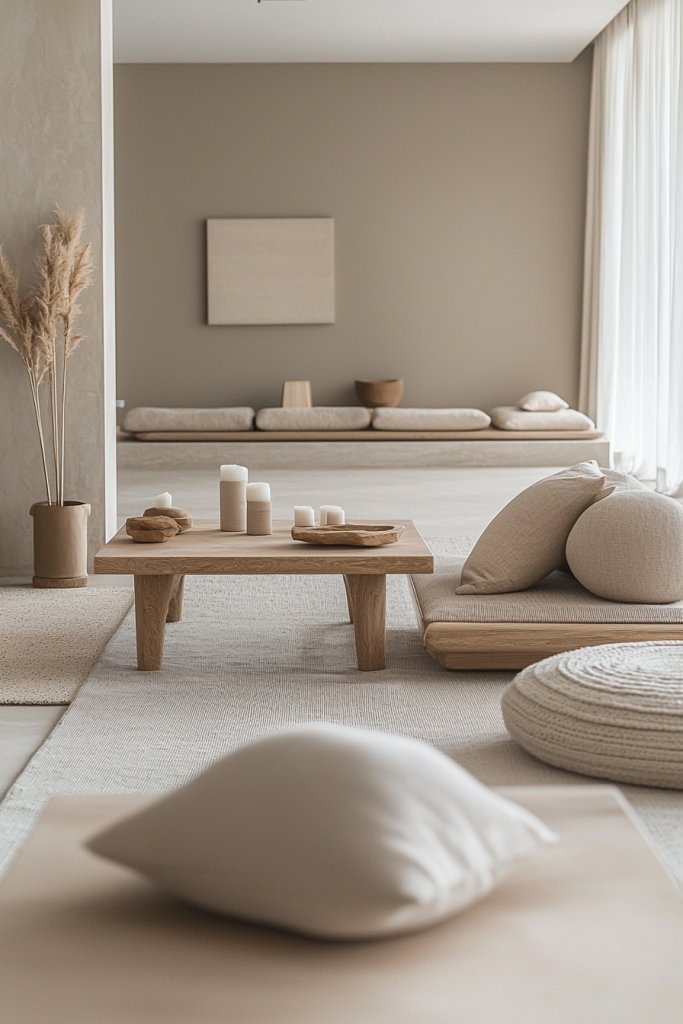
Zen-inspired interiors promote tranquility and mindfulness through balanced design, subtle color schemes, and harmonious arrangements. This approach emphasizes creating a space that encourages relaxation, reflection, and a sense of connection with nature. It’s about cultivating a calm environment that feels both grounding and peaceful.
Visualize a serene room painted in soft taupe or warm beige, with smooth, natural textures that evoke calm—think a low-profile platform bed, a bamboo screen, and a simple, unadorned wooden bench. The decor includes gentle, rounded shapes and symmetrical arrangements that foster balance. Soft textiles like a plush, neutral-toned rug and silky cushions enhance tactile comfort, while a few carefully chosen decorative objects—such as smooth stones or carved wooden accents—add subtle visual interest. The overall atmosphere is quiet and meditative, with filtered natural light creating gentle shadows and emphasizing the space’s harmony.
To craft a Zen-inspired space, start with a neutral color base—like warm beiges or cool greys. Incorporate natural materials such as bamboo, smooth stones, and light wood for furniture and accents. Keep decor minimal: choose a few meaningful, tactile objects and avoid clutter. Use soft textiles, like a low-pile rug or silk cushions, to add comfort. Prioritize symmetry and simplicity in arrangement, creating a balanced environment that promotes mindfulness and a sense of well-being.
14. Vintage Glamour with Velvet Fabrics and Ornate Details
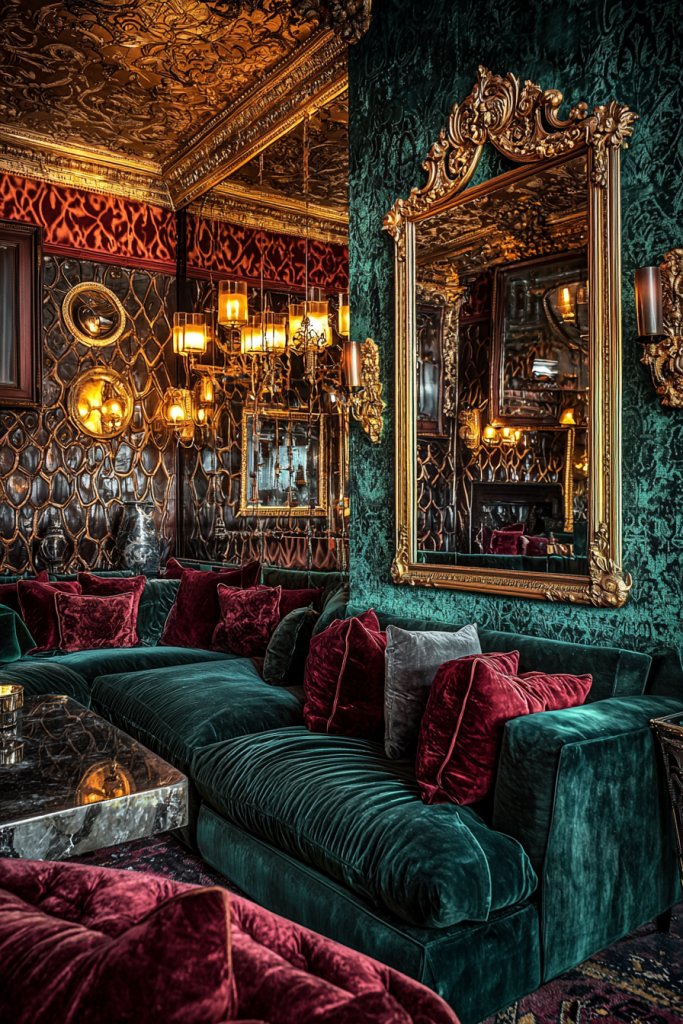
Vintage glamour exudes opulence and timeless elegance, characterized by plush fabrics, ornate details, and a touch of decadence. This style transforms interiors into luxurious retreats, combining historical charm with sophisticated accents. It’s perfect for those who love rich textures and a sense of grandeur.
Imagine a room with a deep emerald velvet armchair, a tufted velvet sofa, and shimmering gold accents throughout. Ornate chandeliers or vintage brass sconces cast a warm glow, highlighting intricate moldings and decorative mirrors. Rich textiles like silk curtains and embroidered cushions add layers of texture, while a vintage Persian rug underfoot anchors the space. Decorative objects—such as antique vases, gilded picture frames, and crystal decanters—complete the opulent tableau. The overall vibe is lush, inviting, and reminiscent of classic Hollywood glamour, with a tactile richness that makes the space feel indulgent.
To recreate this look, select velvet upholstery in jewel tones for furniture pieces. Incorporate metallic accents like gold or brass through lamps, picture frames, and decorative accessories. Add ornate details in elements like carved picture frames or decorative moldings. Use luxurious textiles such as silk curtains and embroidered cushions. Incorporate vintage-inspired lighting fixtures, such as chandeliers or wall sconces, to enhance the glamour. Finish with richly patterned rugs and carefully curated antique accessories to evoke a sense of timeless elegance that feels both refined and inviting.
15. Industrial Chic with Exposed Pipes and Raw Finishes
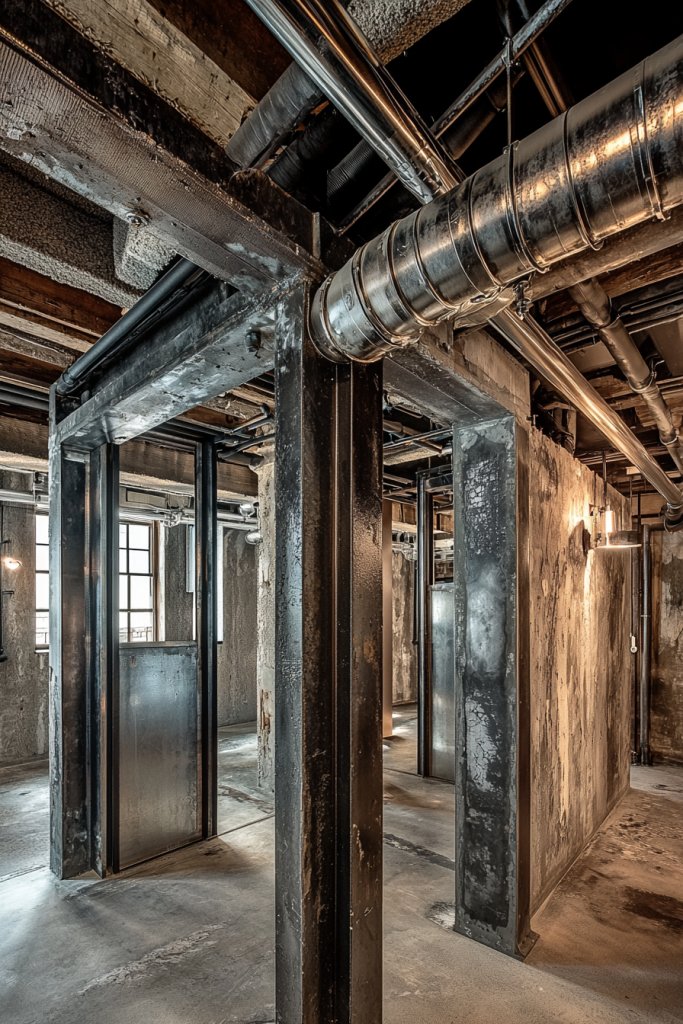
Industrial chic captures urban edge with its raw, unfinished aesthetic, blending utilitarian materials with stylish details. This look celebrates exposed structural elements like pipes and beams, combined with distressed finishes and vintage-inspired decor. It’s perfect for creating a modern, edgy atmosphere with a touch of rugged charm.
Picture a space with exposed black steel pipes running along the ceiling, paired with concrete walls and reclaimed wood accents. The furniture includes metal-framed chairs, a vintage leather sofa, and industrial-style pendant lighting with metal shades. Textures are gritty yet refined, with distressed wood surfaces, brushed metal, and rough concrete floors. Decorative elements focus on simplicity—think metal sculptures, vintage factory accessories, and large, utilitarian clocks. The overall vibe is cool, urban, and functional, with a slightly rugged feel that encourages a creative, no-nonsense environment.
To implement this style, start with raw materials like concrete, reclaimed wood, and brushed metal. Choose industrial pendant lights or vintage metal lamps to add lighting. Incorporate furniture with metal frames or distressed finishes for authenticity. Add vintage-inspired decor such as metal baskets, old factory tools, or large clocks. Keep the color palette neutral—black, grey, brown, and metallics—and avoid overly polished finishes. This style is easy to adapt with affordable, repurposed furniture and DIY touches, making it accessible for beginners seeking a bold, contemporary look.
16. Mid-century Modern with Geometric Shapes and Bold Colors

Mid-century modern design is a timeless style that brings vibrant energy and visual interest to any space through bold colors and striking geometric shapes. This approach often features furniture with clean lines, tapered legs, and organic curves, paired with eye-catching patterns like zigzags, chevrons, or circles. Bright hues such as mustard yellow, teal, burnt orange, and avocado green are common, creating a lively yet balanced atmosphere. Incorporating these elements into a mood board instantly evokes a retro-modern vibe that feels fresh and sophisticated.
Imagine a room where a sleek, low-profile sofa is upholstered in a rich teal fabric, accented by a geometric-patterned rug in black and white. Brightly colored throw pillows with bold chevron prints add a playful touch, while side tables with splayed legs and a sculptural lamp bring in characteristic mid-century flair. Walls could feature a large, abstract art piece with angular shapes in contrasting colors, and curved shelving units display retro-inspired decor objects. The overall look is energetic but harmonious, with a deliberate mix of textures and colors that draw the eye.
To recreate this style, start with a neutral base—think white or soft beige walls—and add statement furniture pieces like a mustard-yellow lounge chair or a teak coffee table. Incorporate geometric patterned textiles such as cushions or curtains, and finish with art prints featuring bold shapes in complementary colors. Use inexpensive options like vinyl decals or DIY-painted furniture for a budget-friendly update. Keep clutter minimal, focusing instead on balanced, coordinated pieces that emphasize the characteristic shapes and hues of mid-century modern design.
17. Soft Pastel Accents for Gentle and Harmonious Spaces
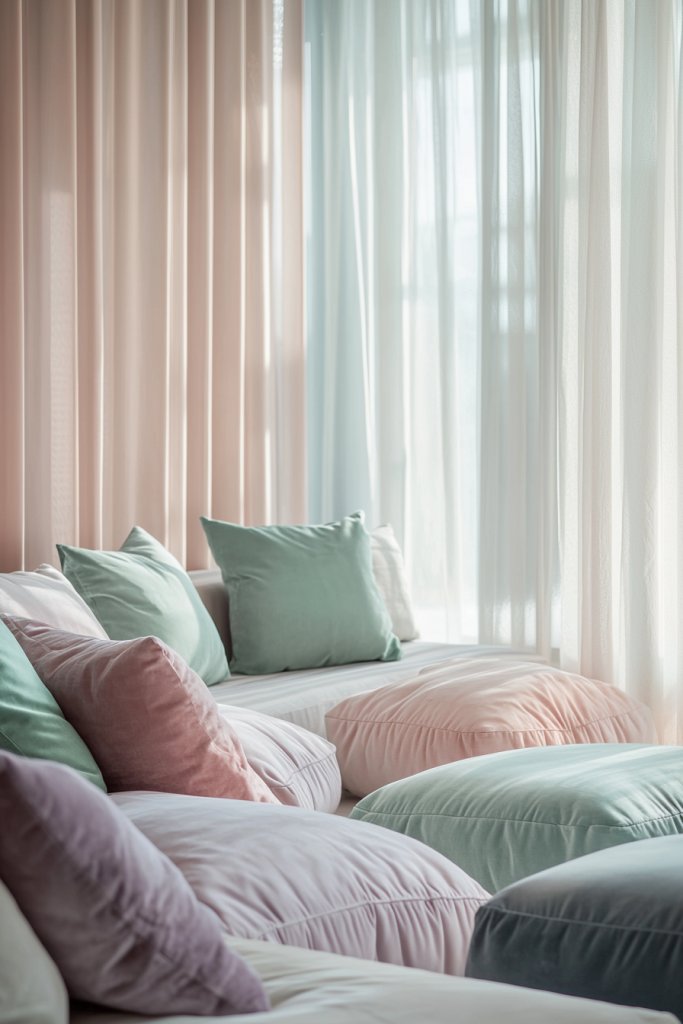
Soft pastel accents create spaces that feel gentle, inviting, and effortlessly harmonious, perfect for a calming retreat within your home. Think of blush pinks, mint greens, lavender, and powder blues that subtly brighten a room without overwhelming it. These hues are often paired with neutral backgrounds like whites, creams, or light greys to enhance their delicate qualities. Incorporating pastel accents through textiles, decor objects, or small furniture pieces helps craft a serene environment that exudes understated elegance.
Picture a cozy living room where plush cushions in blush pink and mint green rest on a neutral-toned sofa, complemented by a soft lavender throw blanket. The walls are painted in a warm, creamy white, while a light grey rug anchors the space. Delicate ceramic vases in pastel shades sit on minimalist side tables, and sheer curtains in a matching hue diffuse natural light softly into the room. The overall effect is a space that feels both fresh and soothing, with textures like velvets, knits, and smooth ceramics adding tactile interest.
To implement this look, start with a neutral base—white or light grey walls—and select textiles in pastel tones for cushions, throws, and curtains. Incorporate small decor items like pastel-colored ceramics or glassware for accents. You can find budget-friendly options in stores or DIY some elements, such as painting plain ceramics or sewing simple cushion covers in pastel fabrics. Keep the palette cohesive by limiting your accent colors to two or three shades, and focus on soft, tactile textures to enhance the calming vibe of your space.
18. Layered Lighting for Ambience and Practicality

Layered lighting transforms a room by balancing functionality with mood, creating a space that feels inviting and adaptable at any time of day. By combining ambient, task, and accent lighting, you can highlight key features, improve usability, and set the perfect atmosphere. This approach ensures your space is both practical for daily activities and cozy for relaxing evenings, making it a cornerstone of thoughtful interior design.
Imagine a living room with a warm, dimmable ceiling fixture providing general illumination, complemented by a pair of table lamps on side tables for reading. Accent lighting could include LED strip lights behind a bookshelf or wall sconces highlighting artwork or architectural details. All these layers work together to create a sense of depth and warmth, with soft, warm-toned bulbs that evoke comfort. The combination of different light sources allows you to easily adjust the mood, whether for a quiet night in or lively gatherings.
To achieve this, start with a central ceiling light—preferably with a dimmer switch—and add task lighting such as table or floor lamps near seating areas. Incorporate accent lighting like LED strips, wall sconces, or decorative lamps for visual interest. Use warm white bulbs (around 2700K) to foster a cozy environment. For easy installation, opt for plug-in options or rechargeable LED options, and keep controls simple with smart bulbs or remote dimmers. This layered approach ensures your space is both functional and beautifully lit, no matter the occasion.
19. Decorative Ceramics and Sculptures as Focal Points

Decorative ceramics and sculptures serve as artistic focal points in interior design, adding personality and a curated feel to your space. Whether it’s handcrafted vases, abstract sculptures, or vintage ceramics, these objects inject character and visual interest without cluttering the room. Placed thoughtfully on shelves, side tables, or mantels, they draw the eye and enhance your overall mood board with their textures and forms.
Picture a coffee table decorated with a trio of glazed ceramic bowls in earthy tones, or a sleek sculpture in matte black nestled on a bookshelf. Small, collectible vases in vibrant colors or intricate patterns can stand out on a sideboard, while larger statement sculptures on the floor or a console table create striking visual anchors. These objects can reflect your personal style—modern, bohemian, or rustic—adding layers of depth and intrigue to your decor. Their tactile textures and varied finishes enrich the sensory experience of your space.
To incorporate decorative ceramics and sculptures, start with a few statement pieces—perhaps a large, textured vase or an abstract sculpture—and arrange them in a balanced, intentional way. Mix high-quality finds with budget-friendly options from thrift shops or craft fairs. Materials like clay, ceramic, resin, or metal work well, and DIY options can include painting or glazing plain objects. Keep the display uncluttered, focusing on a few well-chosen items that complement your overall color scheme and style, creating focal points that elevate your room’s aesthetic.
20. Layered Rugs and Floor Textures for Depth and Warmth
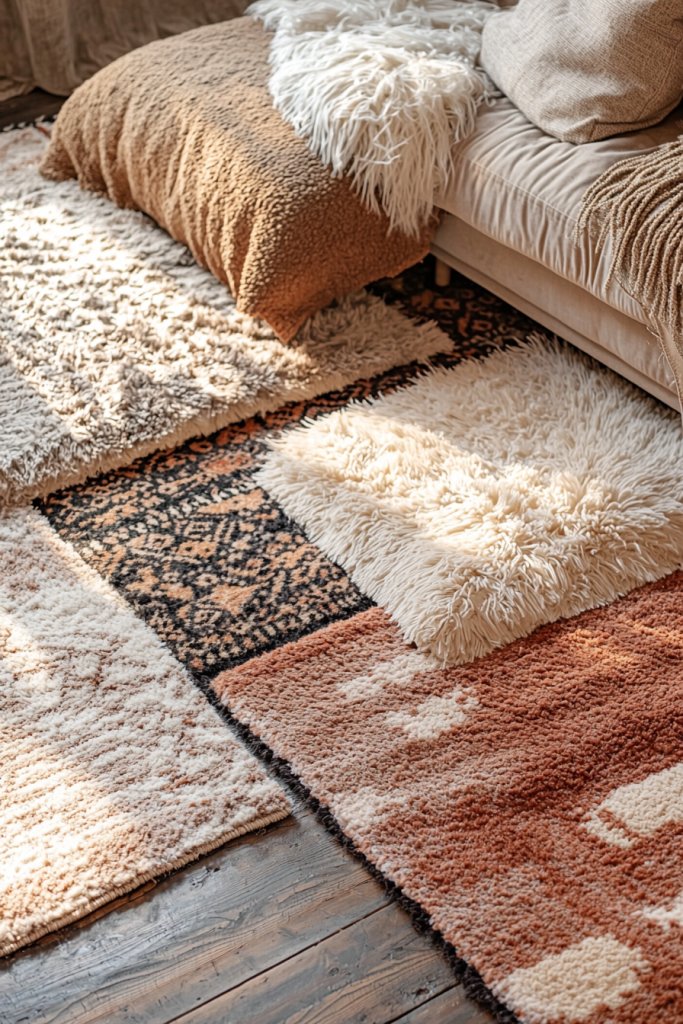
Layered rugs and textured flooring add warmth, depth, and visual interest to any room, making it feel more inviting and comfortable. Combining different sizes, patterns, and textures creates a rich tapestry underfoot that defines separate areas within open-plan spaces or simply enhances the overall ambiance. These layers also soften hard floors, adding tactile comfort and aesthetic sophistication.
Visualize a cozy living room with a large, plush neutral-toned rug as the foundation, topped with a smaller, patterned rug in bold colors that anchors a seating area. The textures vary from soft wool to shaggy or woven textiles, inviting bare feet to feel cozy. The contrasting patterns and textures create a layered look that makes the space feel curated and thoughtful. When you walk across the room, the layered rugs subtly guide your movement and add a sense of intimacy and warmth.
To implement this, start with a large, neutral rug—such as a plush wool or sisal for durability—and add a smaller, decorative rug with a pattern or textured weave for visual interest. Use different materials like jute, shag, or flatwoven rugs to vary tactile sensations. For budget options, look for sales or secondhand finds, and consider DIY projects like sewing together remnants of fabric or re-dyeing rugs for a custom look. This layered approach instantly makes your space feel more layered, inviting, and richly textured.
21. Coordinated Window Treatments for Cohesion
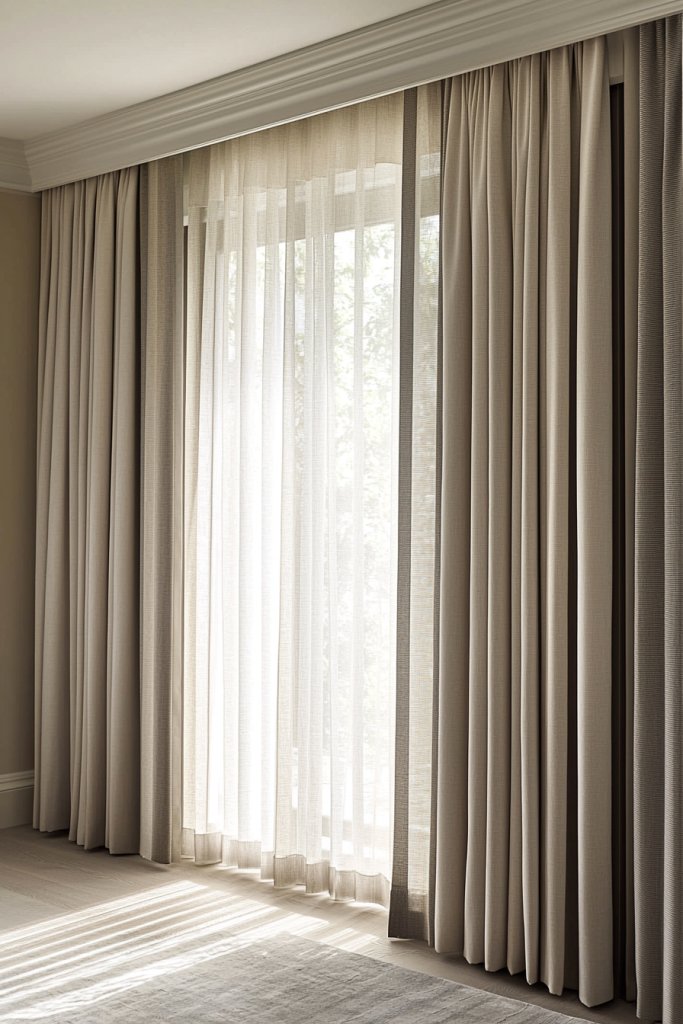
A well-chosen window treatment can be the finishing touch that pulls your entire room together, creating a seamless visual flow. When your curtains, blinds, or shades coordinate with your overall color palette and design style, it elevates the sense of harmony and intentionality in your space.
Imagine soft, flowing linen curtains in a neutral beige that frame large windows, gently diffusing natural light and adding a touch of softness to the room. Alternatively, sleek white roller shades paired with a modern minimalist decor scheme provide a clean, streamlined look. The textures and colors of your window treatments should complement other textiles and decor elements—such as matching cushion covers or rugs—to create a unified aesthetic. The overall effect is a space that feels thoughtfully curated, inviting you to relax and unwind in a cohesive environment.
To achieve this look, start by selecting window treatments that reflect your style—whether it’s airy sheers for a light, breezy vibe or blackout curtains for cozy privacy. Choose colors that harmonize with your walls or furniture, and consider the fabric’s texture to add depth. Installing the treatments with uniform hardware and clean, straight lines helps maintain a polished appearance. For a budget-friendly option, look for ready-made curtains in matching tones or consider DIY options with fabric and simple rods. This small but impactful detail can dramatically enhance the overall harmony of your room.
22. Practical Storage Solutions with Style
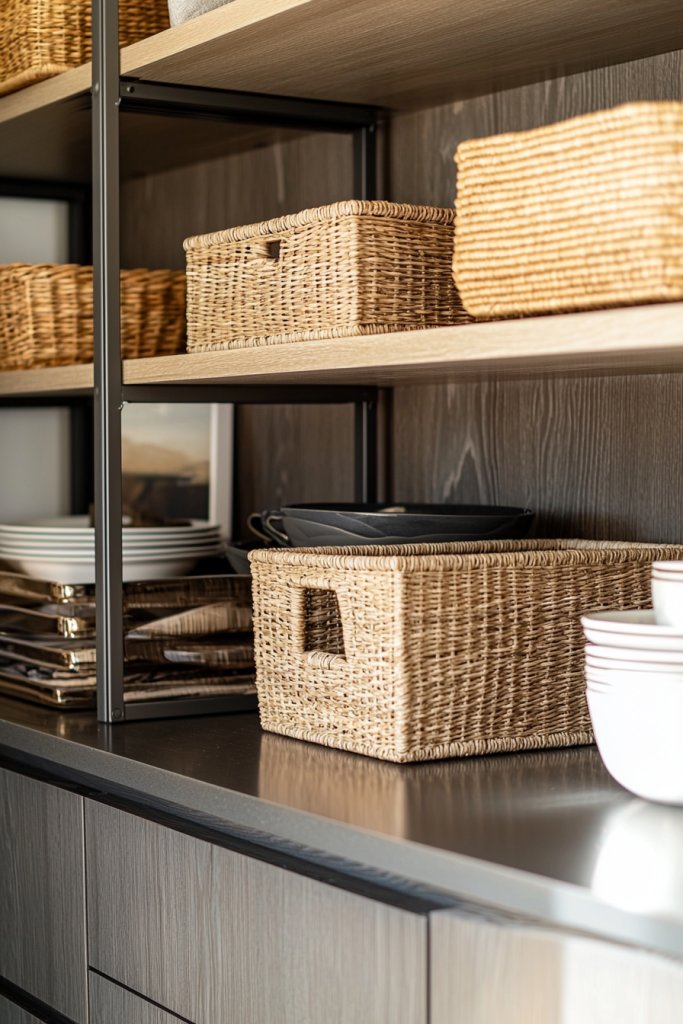
Smart storage solutions are the backbone of a harmonious interior, helping to keep clutter at bay while adding decorative charm. When storage pieces are stylish and functional, they seamlessly blend into your decor, elevating the overall aesthetic.
Picture open woven baskets perched on sleek shelving units, or a set of vintage-inspired wooden boxes stacked neatly in a corner. Multi-functional furniture—such as ottomans with hidden compartments or side tables with built-in storage—offers practicality without sacrificing style. These solutions help maintain a clean, organized space, which in turn fosters a sense of calm and order. Using uniform storage containers and baskets in similar materials or colors creates visual consistency, reinforcing your room’s cohesive look.
Getting started is simple: identify your storage needs first—whether for books, blankets, or miscellaneous items—and then choose stylish containers that suit your decor vibe. Opt for natural materials like wicker, rattan, or wood for a warm, inviting feel, or go for sleek metal or matte plastic for a modern edge. Incorporate attractive storage options into your existing furniture or create dedicated zones for specific items. Keep labels or uniform styling to maintain a tidy, harmonious appearance, making clutter less stressful and your space more enjoyable.
23. Accent Walls with Texture or Pattern for Visual Interest
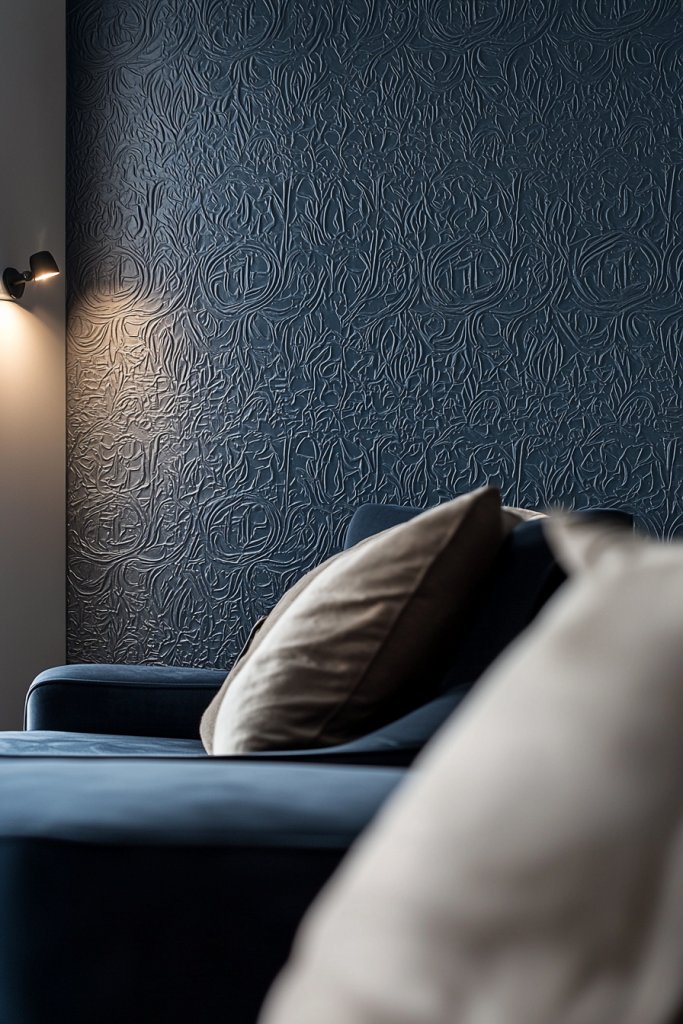
An accent wall is a powerful way to introduce depth, texture, and personality into a room, transforming a plain space into a captivating focal point. When thoughtfully designed, it adds visual interest without overwhelming the overall aesthetic.
Visualize a wall painted with textured plaster in a soft, neutral tone, or adorned with a bold geometric wallpaper in black and white. Alternatively, wooden paneling or decorative paneling with intricate carvings can add tactile richness, making the wall a piece of art in itself. This feature draws the eye naturally, creating a dynamic contrast with adjacent walls painted in calming hues. The key is balancing the pattern or texture so that it enhances the room’s mood rather than competing with other decor elements.
To create your own accent wall, select a material or pattern that complements your style—such as textured wallpaper, shiplap, or a painted mural. Prepare the surface by cleaning and priming it, then carefully apply your chosen treatment, following manufacturer instructions. For wallpaper, measure carefully and use tools like a level for precise application. For DIY textured finishes, consider plaster or stucco kits available at hardware stores. Keep the surrounding decor simple to let the accent wall shine, ensuring it enhances your room’s overall harmony without feeling overpowering.
24. Artful Use of Mirrors to Expand and Brighten Spaces
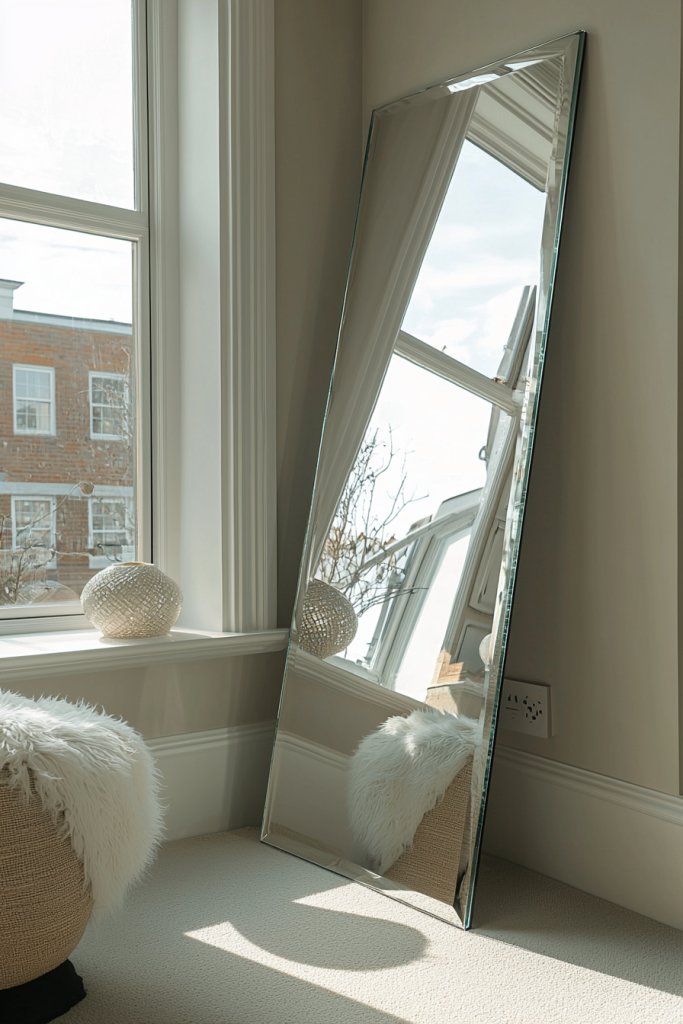
Mirrors are a versatile design tool that can instantly make a room feel larger, brighter, and more balanced. When strategically placed, they reflect light and create a sense of depth, transforming the mood and spatial perception of your interior.
Picture a large, ornate mirror with a gilded frame hanging opposite a window, bouncing natural sunlight throughout the room. Or a series of smaller, curated mirrors in various shapes—round, oval, or geometric—arranged in a gallery style on a feature wall. The reflective surfaces not only visually expand the space but also add a decorative element, contributing to the room’s aesthetic charm. Well-chosen mirrors can serve as focal points or subtle accents, depending on your style.
To incorporate mirrors effectively, identify key locations to maximize light reflection—such as across from windows or near light fixtures. Choose frames that complement your decor style—be it sleek and modern or ornate and vintage. Size matters: larger mirrors work well in open areas, while smaller ones can add interest in tighter spaces. Mount securely at eye level for functional use and aesthetic balance. With a little planning, mirrors can make your space feel more open, inviting, and harmoniously styled.
25. Cohesive Accessory Selection for a Harmonious Finish

Accessories are the finishing touches that tie your entire interior design mood board together, adding personality and polish. When carefully curated, they create a sense of unity and completeness, enhancing the overall harmony.
Imagine a collection of decorative cushions in coordinating fabrics—such as a soft cream velvet pillow paired with textured linen covers—placed on a neutral sofa. Or a set of ceramic vases and sculptures in matching tones, subtly echoing the room’s color palette. Small details like candles, trays, or artful bowls can also serve as accents that reinforce your chosen aesthetic. The goal is to select objects that complement each other in style, color, and scale, avoiding clutter while adding visual interest.
Start by choosing a theme or color scheme from your mood board, then pick accessories that reflect that palette and style. Mix textures and shapes for visual variety but keep the overall look cohesive. Limit yourself to a curated selection—perhaps three to five key pieces—to prevent overwhelming the space. Rearrange and rotate accessories seasonally or as your style evolves. This thoughtful approach ensures every detail contributes to a balanced, harmonious environment that feels personalized and inviting.
Conclusion
With so many inspiring mood board ideas—from calming neutrals and minimalist layouts to vibrant bohemian and vintage glamour—you have endless options to craft harmonious and personalized spaces. Experimenting with these styles and elements can transform your home into a sanctuary that reflects your unique taste and mood. Dive into your design journey with confidence, and let your creativity guide you toward beautifully balanced interiors. Start creating today and turn your vision into a stunning reality.
Leave a Reply